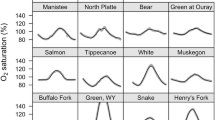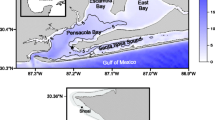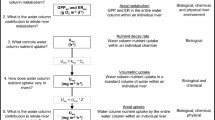Abstract
We summarize rates of metabolism and major sources and sinks of organic carbon in the 148-k long, tidally influenced, freshwater Hudson River. The river is strongly heterotrophic, with respiration exceeding gross primary production (GPP). The P:R ration averages 0.57 (defined as the ratio of GPP to total ecosystem respiration) if only the aquatic portion of the ecosystem is considered and 0.70 if the emergent marshes are also included. Gross primary production (GPP) by photoplankton averages approximately 300 g C m−2 yr−1 and is an order of magnitude greater than that by submersed macrophytes. However, the river is deep, well mixed, and turbid, and phytoplankton spend a majority of their time in the dark. As a result, respiration by living phytoplankton is extremely high and net primary production (NPP) by phytoplankton is estimated to be only some 6% of GPP. NPP by phytoplankton and submersed macrophytes are roughly equal (approximately 20 g C m−2 yr−1 each) when averaged over the river. Emergent marshes are quite productive, but probably less than 16 g C m−2 yr−1 enters the aquatic portion of the ecosystem from these marshes. Heterotrophic respiration and secondary production in the river are driven primarily by allochthonous inputs of organic matter from terrestrial sources. Rates of metabolism vary along the river, with depth being a critical controlling factor. The P:R ratio for the aquatic portion of the ecosystem varies from 1 in the mid-river to 0.2 in the deeper waters. NPP is actually negative in the downstream waters where average depths are greater since phytoplankton respiration exceeds GPP there; the positive rates of NPP occurring upriver support a downstream advection of phytoplankton to the deeper waters where this C is largely respired away by the algae themselves. This autotrophic respiration contributes significantly to oxygen depletion in the deeper waters of the Hudson. The tidally influenced freshwater Hudson largely fits the patterns predicted by the river continuum model for larger rivers. However, we suggest that the continuum model needs to more clearly distinguish between GPP and NPP and should include the importance of autotrophic respiration by phytoplankton that are advected along a river. The organic carbon budget for the tidally influenced freshwater Hudson is balanced to within a few percent. Respiration (54%) and downstream advection into the saline estuary (41%) are the major losses of organic carbon from the ecosystem. Allochthonous inputs from nonpoint sources on land (61%) and GPP by phytoplankton (28%) are the major sources to the system. Agricultural erosion is the major source of allochthonous inputs. Since agricultural land use increased dramatically in the last century, and has fallen in this century, the carbon cycle of the tidally influenced freshwater Hudson River has probably changed markedly over time. Before human disturbance, the Hudson was probably a less heterotrophic system and may even have been autotrophic, with gross primary production exceeding ecosystem respiration.
Similar content being viewed by others
Literature Cited
Adams, M. S. andM. D. McCracken. 1974. Seasonal production of theMyriophyllum component of the littoral of Lake Wingra, Wisconsin.Journal of Ecology 62:457–465.
Brinson, M. M., A. Lugo, andS. Brown. 1981. Primary productivity, decomposition, and consumer activity in freshwater wetlands.Annual Review of Ecology and Systematics 12:123–162.
Coch, N. K., 1986. Sediment characteristics and facies distributions in the Hudson system.Northeastern Geology 8:109–129.
Cole, J. J., N. F. Caraco, andB. Peierls. 1991. Phytoplankton primary production in the tidal, freshwater Hudson River, New York (USA).Vehr. Int. Ver. Limnol. 24:1715–1719.
Cole, J. J., N. F. Caraco, andB. Peierls. 1992. Can phytoplankton maintain a positive carbon balance in a turbid, freshwater, tidal estuary?Limnology and Oceanography 37:1608–1617.
Cole, J. J. and N. F. Caraco. This volume.
Degens, E. T., S. Kempe, andJ. E. Richey. 1991. Biogeochemistry of Major World Rivers, Wiley & Sons, Chichester, England.
Doumele, D. G., 1981. Primary production and seasonal aspects of emergent plants in a tidal freshwater marsh.Estuaries 4: 139–142.
Ellsworth, J. M., 1986. Sources and sinks for fine-grained sediment in the lower Hudson river.Northeastern Geology 8:141–155.
Findlay, S., M. L. Pace, andD. Lints., 1991a. Variability transport of suspended sediments, particulate and dissolved organic carbon in the tidal freshwater Hudson River,Biogeochemistry 12:149–169.
Findlay, S., M. L. Pace, D. Lints, J. J. Cole, N. F. Caraco, andB. Peierls. 1991b. Weak coupling of bacterial and algal production in a heterotrophic ecosystem: The Hudson River estuary.Limnology and Oceanography 36:268–278.
Garritt, R. H., 1990. The metabolism of a submersed macrophyte community in the tidal freshwater Hudson River estuary. M.S. Thesis, Cornell University, Ithaca, New York.
Gladden, J. B., F. R. Cantelmo, J. M. Groom, andR. Shapot. 1988. Evaluation of the Hudson River ecosystem in relation to the dynamics of fish populations.American Fisheries Society Monographs 4:37–52.
Haith, D. A. andL. L. Shoemaker. 1987. Generalized watershed loading functions for stream flow nutrients.Water Resources Bulletin 23:471–478.
Howarth, R. W., J. R. Fruci, andD. Sherman. 1991. Inputs of sediment and carbon to an estuarine ecosystem: Influence of land use.Ecological Applications 1:27–39.
Howarth, R. W., R. Marino, R. Garritt, andD. Sherman. 1992. Ecosystem respiration and organic carbon processing in a large, tidally influenced river: The Hudson River.Biogeochemistry 16:83–102.
Ittekkot, V. andR. W. P. M. Laane. 1991. Fate of riverine particulate organic matter, p. 233–243.In E. T. Degens, S. Kempe and J. E. Richey (eds.), Biogeochemistry of Major World Rivers, Wiley & Sons, Chichester, England.
Kemp, W. M., M. R. Lewis, andT. W. Jones. 1986. Comparison of methods for measuring production by the submersed macrophyte,Potamogeton perfoliatus L.Limnology and Oceanography 31:1322–1334.
Kempe, S., M. Pettine, andG. Gauwet. 1991. Biogeochemistry of European rivers, p. 169–212.In E. T. Degens, S. Kempe, and J. E. Richey (eds.), Biogeochemistry of Major World Rivers. Wiley and Sons, Chichester, England.
Klopatek, J. M. 1975. The role of emergent macrophytes in mineral cycling in a freshwater marsh, p. 367–393.In F. G. Howell, J. B. Gentry, and M. H. Smith (eds.), Mineral Cycling in Southeastern Ecosystems. ERDA CONF. 740513, Springfield, Virginia.
Lewis, W. M., 1988. Primary production in the Orinoco River.Ecology 69:679–692.
Limburg, K. E., M. A. Moran, andW. H. McDowell. 1986. The Hudson River Ecosystem. Springer-Verlag, New York.
Marino, R. andR. W. Howarth. 1993. Atmospheric oxygen exchange in the Hudson River: Dome measurements and comparison with other natural waters.Estuaries, 16:433–445.
Metzger, S. G., R. G. Keppel, P. Geoghegan, andA. W. Wells. 1992. Abundance of selected Hudson River fish species in previously unsampled regions: Effect on standing crop estimates, p. 348–375.In C. L. Smith (ed.), Estuarine Research in the 1980’s, State University of New York Press, Albany, New York.
Meybeck, M., 1982. Carbon, nitrogen, and phosphorus transport by world rivers.American Journal of Science 282:401–450.
Minshall, G. W., K. W. Cummins, R. C. Peterson, C. E. Cushing, D. A. Bruns, J. R. Sedell, andR. L. Vannote. 1985. Development in stream ecosystem theory.Canadian Journal of Fisheries and Aquatic Sciences 42:1045–1055.
Minshall, G. W., R. C. Peterson, K. W. Cummins, T. L. Bott, J. R. Sedell, C. E. Cusing, andR. L. Vannote. 1983. Interbiome comparisons of stream ecosystem dynamics.Ecological Monographs 53:1–25.
Newbold, J. D. 1992. Cycles and spirals of nutrients, p. 379–408.In P. Calow and G. E. Petts (eds.), The Rivers Handbook: Hydrological and Ecological Principles. Blackwell, Oxford, England.
Newbold, J. D., P. J. Mulholland, J. W. Elwood, andR. V. O’Neill. 1982. Organic spiraling in stream ecosystems.Oikos 38:266–272.
New York State Department of Environmental Conservation. 1987. Descriptive data of sewage treatment systems in New York State. New York State Department of Environmental Conservation, Division of Water, Albany, New York.
New York State Department of State, Division of Coastal Resources and Waterfront Revitalization and the Nature Conservancy (NYSDS and TNC). 1990. Hudson River Significant Tidal Habitats. Albany, New York.
Nixon, S. W., 1980. Between coastal marshes and coastal waters—A review of twenty years of speculation and research on the role of salt marshes in estuarine productivity and water chemistry, p. 438–525.In P. Hamilton and K. B. MacDonald (eds.), Estuarine and Wetland Processes, With Emphasis on Modeling. Plenum Press, New York.
Odum, W. E., 1988. Comparative ecology of tidal freshwater and salt marshes, p. 147–176.In R. F. Johnston (ed.), Annual Review of Ecology and Systematics, Vol. 19. Annual Reviews, Inc., Palo Alto, California.
Olsen, C. R., 1979. Radionuclides, sedimentation and the accumulation of pollutants in the Hudson Estuary. Ph.D. dissertation, Columbia University, New York.
Quay, P. D., D. O. Wilbur, J. E. Richey, J. I. Hedges, andA. H. Devol. 1992. Carbon cycling in the Amazon River: Implications from the13C composition of particles and solutes.Limnology and Oceanography 37:857–871.
Raven, J. A. andJ. Beardall. 1981. Respiration and photorespiration.Canadian Bulletin of Fisheries and Aquatic Science 210: 55–82.
Richey, J. E., J. I. Hedges, A. H. Devol, P. Quay, R. Victoria, L. Martinellis, andB. R. Forsberg. 1990. Biogeochemistry of carbon in the Amazon River.Limnology and Oceanograph 35: 352–371.
Richey, J. E., R. L. Victoria, E. Salati, andB. R. Forsberg. 1991. The biogeochemistry of a major river system: The Amazon case study. p. 57–74.In E. T. Degens, S. Kempe, and J. E. Richey (eds.), Biogeochemistry of Major World Rivers, Wiley and Sons, Chichester, England.
Rod, S. R., R. U. Ayres, and M. Small. 1989. Reconstruction of historical loadings of heavy metals and chlorinated hydrocarbon pesticides in the Hudson-Raritan Basin, 1880–1980. Report to the Hudson River Foundation, New York.
Schlesinger, W. H. andJ. M. Melack. 1981. Transport of organic carbon in the world’s rivers.Tellus 33:172–187.
Sedell, J. R., J. E. Riche, and F. J. Swanson. 1989. The river continuum concept: A basis for the expected ecosystem behavior of very large rivers? p. 49–55.In D. P. Dodge (ed.), Proceedings of the International Large River Symposium.Canadian Special Publication of Fisheries and Aquatic Science 106.
Sherman, D., R. Schneider, and R. Howarth. 1994. Distribution and abundance of aquatic macrophytes in the freshwater tidal Hudson River. Report to the Hudson River Foundation, New York.
Stevenson, J. C., 1988. Comparative ecology of submersed grass beds in freshwater, estuarine, and marine environments.Limnology and Oceanography 33:867–893.
Swaney, D. P., D. M. Sherman, and R. W. Howarth. 1996. Modeling water, sediment, and organic carbon discharges in the Hudson/Mohawk basin: Coupling two terrestrial sources.Estuaries 19:xxx–xxx.
Thorp, J. H. andM. D. Delong. 1994. The riverine productivity model: An heuristic view of carbon sources and organic processing in large river ecosystems.Oikos 70:305–308.
UNESCO. 1992. Discharge of Selected Rivers of the World. Volumes II and III. UNESCO, Paris.
United States Geological Survey. 1992. Water Resources Data, New York. Waters Years 1984–1992. Volume 1: Eastern New York Excluding Long Island. United States Geological Survey, Albany, New York.
Van der Leeden, F., F. Ol. Troise, andD. K. Todd. 1990. The Water Encyclopedia. Lewis, Chelsea, Michigan.
Vannote, R. L., G. Minshall, K. W. Cummins, J. R. Sedell, andC. E. Cushing. 1980. The river continuum concept.Canadian Journal of Fisheries and Aquatic Sciences 37:130–137.
Whigham, D. F., J. McCormick, R. E. Good, andR. L. Simpson. 1978. Biomass and primary production in freshwater tidal wetlands of the middle Atlantic coast, p. 3–20.In R. E. Good, D. F. Whigham, and R. L. Simpson (eds.), Freshwater Wetlands: Ecological Processes and Management Potential. Academic Press, New York.
Whigham, D. F. andR. L. Simpson. 1976. The potential use of freshwater tidal marshes in the management of water quality in the Delaware River, p. 173–186.In J. Tourbier and R. W. Pierson, Jr. (eds.), Biological Control of Water Pollution. University of Pennsylvania Press, Philadelphia, Pennsylvania.
Whigham, D. F. andR. L. Simpson. 1977. Growth, mortality, and biomass partitioning in freshwater tidal wetland populations of wild rice.Bulletin of the Torrey Botanical Club. 104:347–351.
White, D. A. andM. J. Simmons. 1988. Productivity of the marshes at the mouth of the Pearl River, LouisianaCastanea 53:215–224.
Whittaker, R. H.. 1975. Communities and Ecosystems, Second Edition. Macmillan, New York.
Author information
Authors and Affiliations
Corresponding author
Rights and permissions
About this article
Cite this article
Howarth, R.W., Schneider, R. & Swaney, D. Metabolism and organic carbon fluxes in the tidal freshwater Hudson River. Estuaries 19, 848–865 (1996). https://doi.org/10.2307/1352302
Received:
Accepted:
Issue Date:
DOI: https://doi.org/10.2307/1352302




